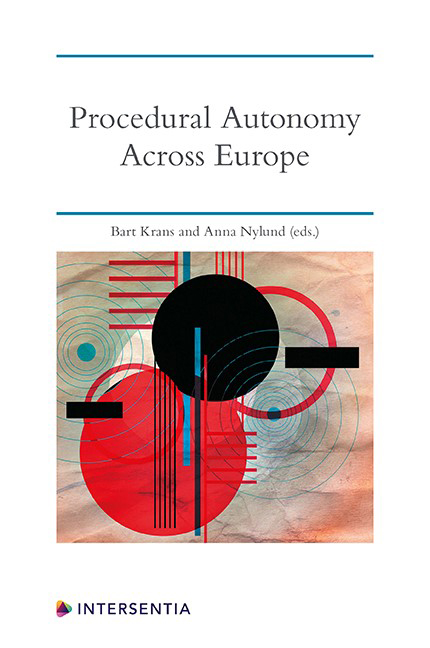Book contents
- Frontmatter
- Preface
- Contents
- Table of Cases
- List of Authors
- Aspects of Procedural Autonomy
- Procedural Autonomy and Belgian Civil Procedure Law: A Turbulent Cohabitation
- The English Approach to Procedural Autonomy
- The Finnish Way of Understanding Procedural Autonomy: A Practical Approach to Implementing EU Civil Procedural Law
- A German Perspective on the Waning Procedural Autonomy in Civil Matters: Who is Afraid of European Civil Procedure?
- Procedural Autonomy in the Netherlands: A Fading Relic?
- Procedural Autonomy, the EEA Agreement and Norwegian Law: The Art of Bridging a Gap and Maintaining it Too
- A Polish Perspective on Collective Civil Proceedings: Reluctance to Follow EU Recommendations?
- Procedural Autonomy between EU Law and the Slovenian Law of Civil Procedure
- Autonomy of the Spanish Legislator in the Regulation of Procedural Law: The Borders of European Case Law
- Procedural Autonomy in Sweden: Is Materielle Prozessleitung the Answer?
- Comparative Insights on Procedural Autonomy
- Index
- ABOUT THE EDITORS
Aspects of Procedural Autonomy
Published online by Cambridge University Press: 30 April 2020
- Frontmatter
- Preface
- Contents
- Table of Cases
- List of Authors
- Aspects of Procedural Autonomy
- Procedural Autonomy and Belgian Civil Procedure Law: A Turbulent Cohabitation
- The English Approach to Procedural Autonomy
- The Finnish Way of Understanding Procedural Autonomy: A Practical Approach to Implementing EU Civil Procedural Law
- A German Perspective on the Waning Procedural Autonomy in Civil Matters: Who is Afraid of European Civil Procedure?
- Procedural Autonomy in the Netherlands: A Fading Relic?
- Procedural Autonomy, the EEA Agreement and Norwegian Law: The Art of Bridging a Gap and Maintaining it Too
- A Polish Perspective on Collective Civil Proceedings: Reluctance to Follow EU Recommendations?
- Procedural Autonomy between EU Law and the Slovenian Law of Civil Procedure
- Autonomy of the Spanish Legislator in the Regulation of Procedural Law: The Borders of European Case Law
- Procedural Autonomy in Sweden: Is Materielle Prozessleitung the Answer?
- Comparative Insights on Procedural Autonomy
- Index
- ABOUT THE EDITORS
Summary
INTRODUCTION
Procedural autonomy plays an important role in the relation between EU law and national civil procedural law. It has traditionally been recognised that Member States are, in the absence of EU procedural law, free to set up the procedural system as they deem fit. Up until the early 2000s the main limitation to procedural autonomy was the requirement of equal and effective protection of rights arising from EU law. Since the early 2000s, Member States have been confronted with a growing body of EU legislation and case law on procedural topics.
Considering that ‘Europe is in a period of increasing Europeanisation of civil procedure’’, it is topical to question whether the term ‘procedural autonomy’ still accurately describes the power of national lawmakers. Perhaps the room for manoeuvre is limited in such a way that procedural autonomy is misleading, and Member States are no longer able to construct their procedural system as they deem fit. The process of Europeanisation of national civil procedure has not come to an end. On the contrary: the influence of Europe on national civil procedure of the Member States is ongoing.
The nature of procedural autonomy has been debated. In EU law, it sometimes refers primarily to ECJ case law where the principles of effective and equivalent protection of rights arising from EU law have been developed and refined. In other settings, procedural autonomy encompasses the wider context of EU law with civil procedural implications. It could also be interpreted as a principle requiring EU law to respect national idiosyncrasies of national law as long as these do not significantly hamper the enforcement of EU law.
Moreover, the perception of procedural autonomy and the manner and intensity to which it limits national civil procedure law may vary among the Member States. These variations could, in turn, have implications for the implementation of EU procedural law. Hence, exploring perceptions of procedural autonomy in the Member States puts the term in a wider context and enables us to assess what procedural autonomy, understood broadly, is today and whether the term procedural autonomy is appropriate today.
- Type
- Chapter
- Information
- Procedural Autonomy Across Europe , pp. 1 - 12Publisher: IntersentiaPrint publication year: 2020



